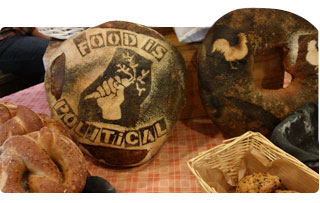A MESSAGE FROM PEGGY
Asheville Bread Festival – Peggy Sutton and Peter Reinhart.
I attended a Midland Fox Hounds event last weekend called the Point–To–Point. It’s a fun–filled family event held in our neighborhood each March featuring horse races for all ages, beginning with stick ponies and ending with the beautiful statuesque thoroughbreds. There’s even a fox hound race to wrap up the afternoon. On my way home I reminisced about my first independent mode of transportation being a horse. Our county is rural and we could get to the local store or a friend’s home faster on the back of a horse than trying to convince Mama to take us in the car. I grew up 20 miles from the nearest town and 25 miles from the nearest city. I’m still in the neighborhood and love it although I’ve traded my horse in for a truck, van, and jeep. These days Jeff and I call our horses ELO’s (Expensive Lawn Ornaments) and that’s okay with us.
As unforeseen things happen in life, three days after we placed our sprouted rolled oats on the web site we experienced an equipment issue. I apologize that we’ve had to temporarily remove them from the web site, but hope to offer them again soon. We’ve begun construction of our new building that will house our certified gluten–free facility. Depending on the weather this spring we anticipate being operational in about six months.

To Your Health is in the March issue of Food and Wine magazine. We’re excited to be included in this great sprouted write up.
My newest gadget purchase is a Bosch Universal Mixer . It’s wonderful! I can achieve a great window pane test in 3–4 minutes for my basic French bread recipe. Hand kneading sometimes would take at least 15 minutes. My next venture with the Bosch is sourdough. I’ll be sure to let you know how it goes. . It’s wonderful! I can achieve a great window pane test in 3–4 minutes for my basic French bread recipe. Hand kneading sometimes would take at least 15 minutes. My next venture with the Bosch is sourdough. I’ll be sure to let you know how it goes.
Lastly, there have been several articles circulating regarding the high percentage of grain crops grown with genetically modified seeds. Rest assured that To Your Health and our grain suppliers are all certified organic which requires that our grains are NOT genetically modified in any way. Hybridization and GMO do not mean the same thing by any stretch. Our company’s Non–GMO policy states: To Your Health Sprouted Flour Co. believes that the profitability of farming and food security will both improve without genetic engineering if farmers and researchers put more effort toward developing ecologically sustainable systems. We oppose the use of genetic engineering in agriculture. We do not use genetically modified grains in the making of our sprouted grains and flours.

The Asheville Bread Festival was a wonderful weekend filled with fabulous breads and pastries, lots of great bakers, and all surrounded by the beautiful Appalachian Mountains. I’m pictured with Peter Reinhart, my favorite bread baker and mentor. Peter has taught me how to make great bread through his instruction in all his many books. I enjoyed his workshop at the festival featuring recipes for making delicious gluten–free, sugar–free baked goods.

You can pre-order Peter’s new book, The Joy of Gluten–Free, Sugar–Free Baking, and get $10 off the cover price at www.thejoyofgluten-freesugar-freebaking.com. This great new baking book features over 80 low–carb recipes that offer solutions for gluten sensitivity, diabetes, and weight loss.
Back to top


- 1 cup plus 3 table spoons water
- 3 tablespoons olive oil
- 3 cups sprouted flour (wheat or spelt works best)
- 1 ½ teaspoons sea salt
- 1 ½ teaspoons honey
- 1 packet dry active yeast
- 2 tablespoons dried herbs of choice (optional)
Place all ingredients in a food processor and mix well. Continue to blend for about 2 minutes. Let dough rise in processor bowl for about 1 hour. Remove dough from bowl and spread with fingers onto a baking sheet or pizza pan that has been lightly bushed with olive oil. Let dough rest for 15–20 minutes. Load with favorite toppings. Bake at 450 degrees for 12–15 minutes. Let pizza rest for about 5 minutes before cutting.
NOTE: I like to preheat my oven for 1 hour with a pizza stone on the bottom shelf. Preheating for this length of time helps heat to evenly distribute throughout your oven for even baking of your crust.

Back to top


Back to top


Excerpt from www.traditional-foods.com
Rye berries grow as a grass closely related to wheat and barley. Until about 400 BC this grass was considered a weed. Wheat and barley were the preferred grains and rye berries were ignored by all but the wandering four-legged animals that had an eye for good nutrition.
Until recent interest in rye berries because of their low gluten and high water-soluble fiber content, the use of rye has been spotty in culinary history. Rye berries found a place in rye bread and pumpernickel, in whiskey and vodka, in cereal and animal fodder. The flavor most people associate with rye comes from their experience with rye bread. The flavoring agent in rye bread is caraway seed. Caraway flavor is in no way indigenous to rye berries.
Probably because it will survive a snow storm, rye has been widely used in Eastern Europe where a barley or wheat crop would be wiped out with such freezing weather. From those cold regions you can find bread recipes calling for only rye flour. Such recipes came about because there was only rye flour to work with. Rye berries have been referred to as "black wheat".
Most recipes for rye bread call for no more than 1/3 of rye flour to 2/3 wheat flour. Rye is low in gluten which makes it difficult to handle in bread making. A 100% rye bread is very dark and heavy. Adding wheat flour causes the bread to rise better, having a lighter texture much more suited to the Western palate.
In cooking the whole rye berry, rye berries make a fine substitute for the more commonly used rice. The texture is chewy and flavor rather like walnuts. Anyone appreciating the taste of wild rice will enjoy cooked rye berries. To cook, rinse ½ cup of berries and place in a saucepan with 1 ¾ cups water and ¼ teaspoon sea salt. Bring the mixture to a boil then cover and lower the heat. Simmer for an hour or until the rye berries are tender. Drain off any remaining liquid. Use these cooked rye berries as a cereal, as a side dish, as an addition to soup and a countless number of other ways.
One form of rye berry is the rye flake. The flake is made by cutting and rolling the rye berry into a flat affair resembling rolled oats. This form of rye is popular in cereals and in grain mixes for baking bread.

Nutrients in Rye Berries – Rye berries will add a nice portion of B vitamins and minerals to your diet. Note in the table that they are particularly high in manganese. With many grains, we alert readers to their phytic acid— a substance that can inhibit your absorption of minerals from the rye berries content (TYH NOTE: Sprouted rye berries and sprouted rye flour have eliminated most of the grain's phytic acid content). One great benefit of rye is that it is high in the phytase enzyme that breaks down phytic acid. When rye flour is mixed with wheat, as it is in many bread recipes, the enzymes in the fresh rye flour will help break down the phytic acid in the entire loaf, including in the wheat.
Back to top


Congratulations to our Olympic Woman!! Maria placed 5th overall in the World Cup races she recently vied for in Germany. Please go to www.marialamb.com for the entire update and wish her well. Maria incorporates lots of sprouted grains and flours in her daily diet during training as well as when she has time off.
Back to top


Slightly changed version of the fabulous recipe posted at www.Beyond the Peel.com, a great web site for creative whole food recipes.
- 1 cup sprouted Kamut berries (my suggestion is to use sprouted berries)
- 1 cup fresh cilantro leaves, packed
- 1 cup fresh mint leaves, packed
- ½ cup feta, crumbled
- ½ cup hazelnuts, roasted
In a heavy saucepan, add 1 cup of sprouted Kamut berries with 3 cups of water. Bring to a boil and simmer covered until desired doneness is reached. Begin checking after 20 minutes to ensure berries don’t overcook. Sprouted berries will cook quicker than un-sprouted berries. Like wild rice, some backbone should remain. Soaking overnight reduces the cooking time. Drain and rinse the Kamut with cold water to cool the grains for the salad. Save time by making this the night before while you're watching TV or eating dinner. Roast the hazelnuts while the Kamut is cooking. Set the oven to 325 degrees. Spread the hazelnuts on the baking sheet and roast until fragrant, about 7 to 10 minutes.
Wash cilantro and mint. Remove the leaves from the stem (optional). If you choose to skip this step, chop the herbs before measuring.
In a large bowl, add the kamut, cilantro, mint, feta and hazelnuts. Add the dressing and toss to coat.
Vinaigrette
- 1 tablespoon olive oil (I use about 2–3 tablespoons)
- 1 teaspoon lemon juice
- 2 teaspoons cider vinegar
- 1 teaspoon honey or to taste
- Salt and pepper to taste
Combine all the ingredients together until honey has dissolved.

Back to top
|